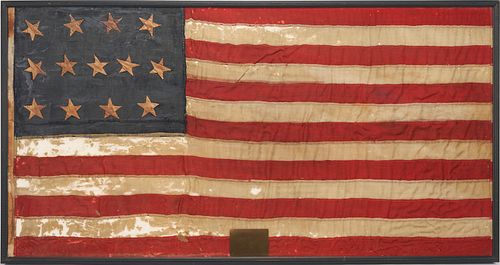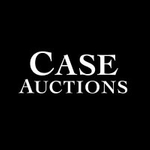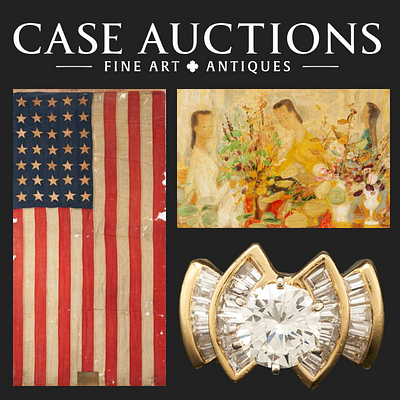Admiral John Winslow's 13 Star Flag
About Seller
4310 Papermill Dr. NW
Knoxville, TN 37909
United States
Case Auctions is based in Knoxville, Tennessee, where our gallery is located, with satellite offices in Nashville, Tennessee and Kingsport, TN – but our reach is worldwide. Established in 2005, we conduct cataloged auctions of investment-quality art and antiques under the stewardship of knowledgeabl...Read more
Two ways to bid:
- Leave a max absentee bid and the platform will bid on your behalf up to your maximum bid during the live auction.
- Bid live during the auction and your bids will be submitted real-time to the auctioneer.
Bid Increments
| Price | Bid Increment |
|---|---|
| $0 | $10 |
| $100 | $25 |
| $500 | $50 |
| $1,000 | $100 |
| $3,000 | $200 |
| $5,000 | $500 |
| $10,000 | $1,000 |
| $20,000 | $2,000 |
| $50,000 | $5,000 |
| $100,000 | $10,000 |
About Auction
Jul 8, 2023
We invite you to participate in our Two-Day Summer Auction on Saturday, July 8th, 2023 at 9 AM EST and Sunday, July 9th at 1 PM EST. This auction will take place at our Knoxville gallery. Please click here to learn more about our auction and register to bid. Case Auctions bid@caseantiques.com
- Lot Description
Rear Admiral John Ancrum Winslow's U.S. Navy 13 Star Boat Flag, possibly used during the historic Civil War naval victory of the USS Kearsarge over the CSS Alabama on June 19, 1864 off the coast of Cherbourg, France, and descended in his family along with several other Kearsarge/Winslow family objects in this auction. The entirely hand stitched flag features thirteen slightly irregular double-appliqued stars arranged horizontally in three rows of four-five-and-four on a blue canton, and thirteen red and white stripes. The bunting is made of sheep's wool, dyed with madder (confirmed by microanalysis) with cotton apparently used for the stars. The header is pierced with four hand-fashioned whip-stitched grommets. The flag measures 70" x 36" overall and is stitch mounted under plexiglass in an ebonized custom frame. The framing includes a mid 20th century brass plaque which incorrectly identifies the flag's composition as linen and misattributes it to 1784. Rather, it is more likely that the flag dates from the mid 19th century, raising the likelihood that, like the 35-star flag in the preceding lot (#562), it may have been used on the USS Kearsarge, which Winslow commanded.
We wish to thank flag historian James Ferrigan for his assistance in researching and cataloging this flag. A copy of his full, 9-page report on this flag is available on request and will be provided to the winning bidder. In it, Mr. Ferrigan notes, "During the period of the U.S. sailing navy and the early steam powered navy, nearly all ships possessed small boats, propelled by oars or small sails. These smaller craft permitted the transfer of personnel of small cargoes from ship to shore or ship to ship on open sea. Like their mother ships, these gigs or small boats carried a stern staff for a small ensign. The small ensigns flown on these gigs were called Boat Flags by the U.S. Navy. These flags are highly prized because of their size. Most 19th century Naval Flags were quite large [but] the smaller boat flags provide a convenient alternative for both collectors and scholars alike. This example bears similarities to other U.S. Navy boat flags, in particular the reported size of 36" x 70". A review of U.S. Navy 'Tables of Allowances' reveals that this is very similar to the Size 13 in use during the Civil War... additionally, this flag is finished with four whipped stitched eyelets on the heading, and these are often found on naval boat flags which were affixed to a stern staff for use in small boats. It was quite common for 19th century American Naval officers to retain flags from their various commands and similar Navy boat flags from other famous American Civil War naval families - Decatur, Farragut and Porter - are documented in museum collections. It is not known when this boat flag was framed, but its similarity [to] the frame of another 35 star flag from the USS Kearsarge [lot 562] makes it highly likely that both Winslow family flags were from the Kearsarge."
Boat flags were issued for each of the launches of larger warships, of which the Kearsarge had four; the Kearsarge's abstract log, also offered in this auction [lot 561], records several instances of its launches being use to transport Captain Winslow between ship and shore to plan the battle and for use in rescuing survivors of the Alabama as it sank. It was not uncommon for ships to use flags of varying designs, and the traditional 13 star flag design of this flag - which the U.S. Navy has used throughout its history - would likely have appealed to Ancrum, a lifelong patriot and Mayflower descendant. Only four known surviving flags from the USS Kearsarge are known; three of these are in museums today (the one in the Smithsonian donated by the Winslow family, and two in the U.S. Navy system), and the one in lot #562 of this auction.(For a full discussion of that flag, framed the same as this one, and the use of flags on board the Kearsage, see the catalog entry for lot #562).
Note: The CSS Alabama, the most feared and successful raider of the Confederacy, had been attacking Union merchant ships since her launch on May 15,1862, significantly cutting off international commerce and income for the Union. John Ancrum Winslow and the crew of the USS Kearsarge earned international recognition by ending the Alabama's seige in one of the two most famous single ship versus single ship actions of the American Civil War (the other being the duel of the ironclads CSS Virginia versus the USS Monitor). Both had significant affects on the naval actions of the Civil War and beyond.
Winslow was a Southerner himself by birth, born 1811 in Wilmington, North Carolina. But his father, a descendant of Mayflower passengers Mary Chilton and John Winslow, insisted he attend school in New England. Politically powerful family friend Daniel Webster helped young Winslow secure a job as midshipman in 1827. He went on to earn distinction for his efforts during the capture of Tobasco in the Mexican War. However, Winslow experienced his first significant failure two years later when he lost his first command (of the USS Morris) in a gale. It was around this time that he first met Raphael Semmes, who had suffered the same embarrassment; the two were roommates on the USS Raritan. They would serve on opposite sides, however, of the Civil War. Winslow began the War commanding the gunboat Benton under Andrew Foote, but he was unable to participate in the important Fort Henry, Island No. 10 and Memphis operations due to a freak accident that injured his arm in December 1861. A combination of other health setbacks (including the loss of an eye) and political missteps within the Navy threatened to relegate Winslow to low profile assignments. In 1862, he was given what may have seemed to some an impossible task: to hunt down Confederate raiders, specifically the notorious Alabama. On April 6, 1863, he formally assumed charge of the USS Kearsarge, a 1550-ton Mohican class steam sloop of war named for Mt. Kearsarge in New Hampshire. In June, 1864, Winslow and his crew discovered the Alabama in the port of Cherbourg, France, undergoing repairs. The action commenced on June 19, and following a brief but intense battle, the Kearsarge sank the feared raider to the bottom of the sea while remaining relatively unscathed. Captain John Winslow became a Union hero. The Kearsarge victory won him a promotion to Commodore and he was voted the thanks of Congress. He was advanced to Rear Admiral in 1870 and commanded the Pacific Squadron until 1872, a year before his death of natural causes. Multiple United States Navy ships have been named in honor of both the Kearsarge and of Winslow himself.
Biography Sources: USS Kearsarge Ship's Log; John Morris Ellicott: The Live of John Ancrum Winslow, G.P. Putnam's Sons, 1902; Dictionary of North Carolina Biography, 6 volumes, edited by William S. Powell. Copyright 1979-1996 by the University of North Carolina Press.Condition
Conserved in the mid-20th century. Stitch mounted and adhered to a linen red white and blue backing (corresponding to flag pattern). Varnish has been applied over the blue canton and stars. The weight of the glued and varnished canton appears to have caused stress on the white stripe below. Red threads have thicker spun fibers than the white and have held up better. Several stitched repairs to the stripes, and a few areas of reinforcement to thread. Conservation appears older than the frame. Flag does not appear cut down. 4 Grommets and header stitching appear original. Expected grime. For an in-depth condition report and further conservation recommendations, refer to the accompanying flag report by James Ferrigan.
- Provenance
Private TN collection, acquired March, 2023 from direct descendant of USS Kearsarge commander Admiral John Ancrum Winslow (1811-1873) through his only surviving grandson Brig. Genl. Eben Eveleth Winslow, along with other items in this auction.
- Shipping Info
-
Buyer pays shipping and is responsible for making arrangements through our recommended shippers or an outside shipper of your choice. For pre-auction estimates, provide the lot number(s) to the recommended shipper(s) of your choice:
The UPS Store of Bearden Contact - Joe 865-584-0081 (press 5), fax 865-584-0094 store2630@theupsstore.com
The UPS Store of Northshore Contact - Eve 865-951-2499 store6461@theupsstore.com
John & Max Express LLC NOTE: white glove delivery for furniture, fine art, and freight items (driving range limitations may apply, US only) Contact - Yev or Nadiya 865-230-1567 johnmaxexpress@gmail.com
Package Manager (UPS, FedEx, USPS, & DHL) NOTE: Crate and large freight services are also offered Contact - Burak 865-584-3000 Info@packagemanager.net
-
- Payment & Auction Policies
-
Available payment options
Payment must be received no later than five (5) days after the sale.
If paying with a credit card, a 3.5% credit card processing fee will be applied to the final sales price (i.e. hammer price + buyer's premium + applicable taxes). If you have a credit card on file with Case, any winning bids will be automatically charged (up to $3000) along with applicable fees 72 hours after you receive your invoice unless other arrangements have been made.
If paying with wire transfer, please use the following information:
Bank: Pinnacle Bank
150 Third Avenue South, Suite 900
Nashville, TN 37201
Phone # (865) 766-3000
Swift Code: PNFPUS44
Routing, Transit, ABA: 064008637
Beneficiary: Case Antiques, Inc.
4310 Papermill Drive
Knoxville, TN 37909
Account #: NOT DISCLOSED (please refer to your invoice email for the Deposit Account Number or contact us )
-
-
- Buyer's Premium



 EUR
EUR CAD
CAD AUD
AUD GBP
GBP MXN
MXN HKD
HKD CNY
CNY MYR
MYR SEK
SEK SGD
SGD CHF
CHF THB
THB


























